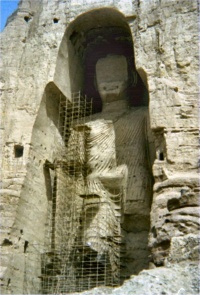Buddhas of Bamiyan: Difference between revisions
Pablo Sender (talk | contribs) |
|||
| (One intermediate revision by one other user not shown) | |||
| Line 1: | Line 1: | ||
[[File:Buddha of Bamiyan.jpg|right|200px]] | |||
'''The Buddhas of Bamiyan''' (Persian: بت های باميان – bothā-ye Bāmiyān) were monumental statues of standing buddha carved into the side of a cliff in the Bamyan valley in the Hazarajat region of central Afghanistan, 230 kilometres (140 mi) northwest of Kabul at an elevation of 2,500 metres (8,200 ft). Modern Archaeologists believe they were built around 550 CE, although [[H. P. Blavatsky]] claims they are remnants of "the Initiates of the [[Fourth Root-Race|Fourth Race]]."<ref>Helena Petrovna Blavatsky, ''The Secret Doctrine'' vol. II, (Wheaton, IL: Theosophical Publishing House, 1993), 339.</ref> They were dynamited and destroyed in March 2001 by the Taliban after they declared that they were idols, carrying out an extreme Islamic religious iconoclasm. | '''The Buddhas of Bamiyan''' (Persian: بت های باميان – bothā-ye Bāmiyān) were monumental statues of standing buddha carved into the side of a cliff in the Bamyan valley in the Hazarajat region of central Afghanistan, 230 kilometres (140 mi) northwest of Kabul at an elevation of 2,500 metres (8,200 ft). Modern Archaeologists believe they were built around 550 CE, although [[H. P. Blavatsky]] claims they are remnants of "the Initiates of the [[Fourth Root-Race|Fourth Race]]."<ref>Helena Petrovna Blavatsky, ''The Secret Doctrine'' vol. II, (Wheaton, IL: Theosophical Publishing House, 1993), 339.</ref> They were dynamited and destroyed in March 2001 by the Taliban after they declared that they were idols, carrying out an extreme Islamic religious iconoclasm. | ||
| Line 11: | Line 12: | ||
==Online resources== | ==Online resources== | ||
* [https://theosophy.world/encyclopedia/bamian-statues Bamian Statues] at Theosophy World | |||
===Articles=== | ===Articles=== | ||
* [http://www.theosociety.org/pasadena/sunrise/50-00-1/as-hpb.htm The Bamian Statues: Their Mysterious Origin] by H. P. Blavatsky | * [http://www.theosociety.org/pasadena/sunrise/50-00-1/as-hpb.htm The Bamian Statues: Their Mysterious Origin] by H. P. Blavatsky | ||
Latest revision as of 13:53, 7 April 2020
The Buddhas of Bamiyan (Persian: بت های باميان – bothā-ye Bāmiyān) were monumental statues of standing buddha carved into the side of a cliff in the Bamyan valley in the Hazarajat region of central Afghanistan, 230 kilometres (140 mi) northwest of Kabul at an elevation of 2,500 metres (8,200 ft). Modern Archaeologists believe they were built around 550 CE, although H. P. Blavatsky claims they are remnants of "the Initiates of the Fourth Race."[1] They were dynamited and destroyed in March 2001 by the Taliban after they declared that they were idols, carrying out an extreme Islamic religious iconoclasm.
According to H. P. Blavatsky, these statues are witnesses of earlier civilizations. She rejected the fact that the statues represent the Buddha, claiming they come from the ancestors of the Miao people, and were "the work of the Cyclopes, the true and actual Giants of old."[2] Being built far before the birth of Gautama, they were made to look like him in modern times. As archaeologists discovered, the main bodies were hewn directly from the sandstone cliffs, but details were modeled in mud mixed with straw, coated with stucco. Blavatsky explains:
The Buddhist Arhats and Ascetics found the five statues, and many more, now crumbled down to dust, and as the three were found by them in colossal niches at the entrance of their future abode, they covered the figures with plaster, and, over the old, modelled new statues made to represent Lord Tathagata. The interior walls of the niches are covered to this day with bright paintings of human figures, and the sacred image of Buddha is repeated in every group. These frescoes and ornaments—which remind one of the Byzantine style of painting—are all due to the piety of the monk-ascetics, like some other minor figures and rock-cut ornamentations. But the five statues belong to the handiwork of the Initiates of the Fourth Race, who sought refuge, after the submersion of their continent, in the fastnesses and on the summits of the Central Asian mountain chains.[3]
Blavatsky states that the sizes of the statues had an esoteric meaning:
Moreover, the five statues are an imperishable record of the esoteric teaching about the gradual evolution of the races.
The largest is made to represent the First Race of mankind, its ethereal body being commemorated in hard, everlasting stone, for the instruction of future generations, as its remembrance would otherwise never have survived the Atlantean Deluge. The second—120 feet high—represents the sweat-born; and the third—measuring 60 feet—immortalizes the race that fell, and thereby inaugurated the first physical race, born of father and mother, the last descendants of which are represented in the Statues found on Easter Isle; but they were only from 20 to 25 feet in stature at the epoch when Lemuria was submerged, after it had been nearly destroyed by volcanic fires. The Fourth Race was still smaller, though gigantic in comparison with our present Fifth Race, and the series culminated finally in the latter.[4]
Online resources
- Bamian Statues at Theosophy World
Articles
- The Bamian Statues: Their Mysterious Origin by H. P. Blavatsky
Notes
- ↑ Helena Petrovna Blavatsky, The Secret Doctrine vol. II, (Wheaton, IL: Theosophical Publishing House, 1993), 339.
- ↑ Helena Petrovna Blavatsky, The Secret Doctrine vol. II, (Wheaton, IL: Theosophical Publishing House, 1993), 337.
- ↑ Helena Petrovna Blavatsky, The Secret Doctrine vol. II, (Wheaton, IL: Theosophical Publishing House, 1993), 339.
- ↑ Helena Petrovna Blavatsky, The Secret Doctrine vol. II, (Wheaton, IL: Theosophical Publishing House, 1993), 339-340.
